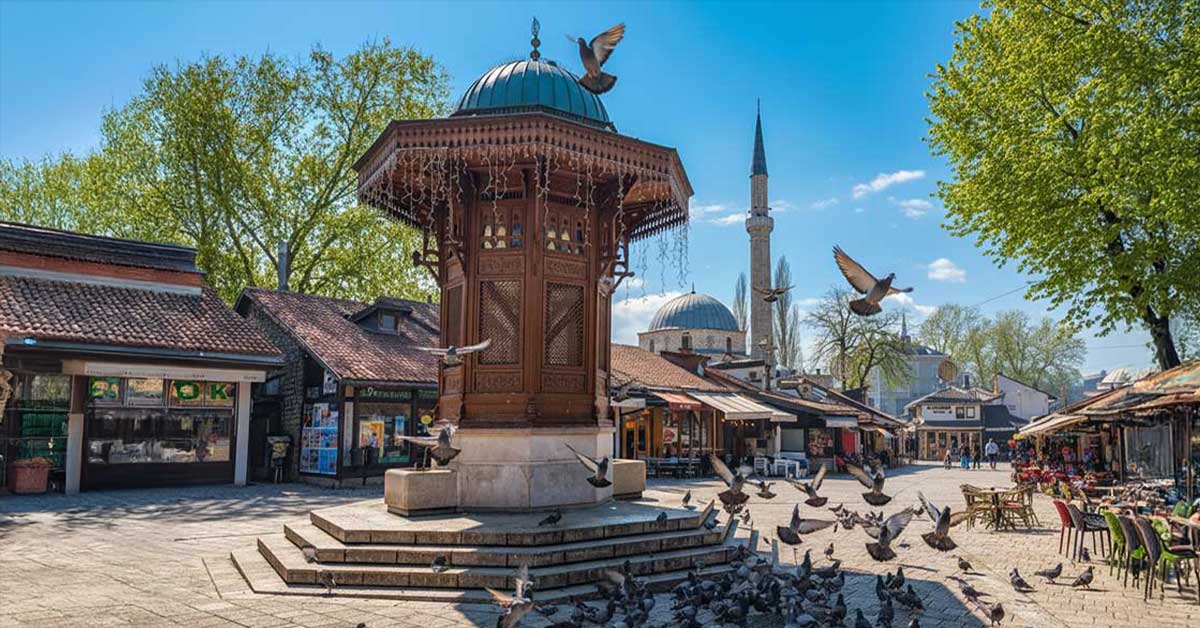Why Baščaršija Isn’t Just a Tourist Spot (But a Portal to Another Time)
Imagine walking on cobblestones that remember the footsteps of sultans. You hear the hammering from a workshop where copper is shaped with the same rhythm for five centuries. The smell of ćevapi mixes with the aroma of Turkish coffee, while the call to prayer echoes together with the ringing of church bells. Welcome to Baščaršija – a place where East and West don’t just meet, they embrace.
But careful – this isn’t a story for those who want neat, sterile museum exhibits. Baščaršija is alive. It breathes, sweats, laughs, and cries. Sometimes it smells like roses, sometimes like sewage. And that raw authenticity is exactly where its magic lies.
Table of Contents
History: When the Ottomans Built Their Dream
Isa-Beg Ishaković – The Man Who Saw the Future
In 1462, while Europe was still trying to figure out what had just happened to Constantinople, Isa-Beg Ishaković stood by the Miljacka river and envisioned a city. Not just any city – but the economic heart of the Balkans.
Baščaršija (from Turkish baş çarşı – main bazaar) wasn’t born by accident. It was a carefully planned urban symphony:
Bezistan – an enclosed marketplace for luxury goods
Hans– 15th-century hotels with stables
Hamams – because cleanliness is half of faith
Mosques – the spiritual compass of traders
Fountains and sebiljs – free water for everyone
Fun fact that’ll blow your mind: in its golden days, Baščaršija had over 80 different crafts! From abadžije (wool cloth makers) to žuždžije (dye producers). Today, barely a dozen authentic ones survive.
Sebilj – The 16th-Century Instagram Star
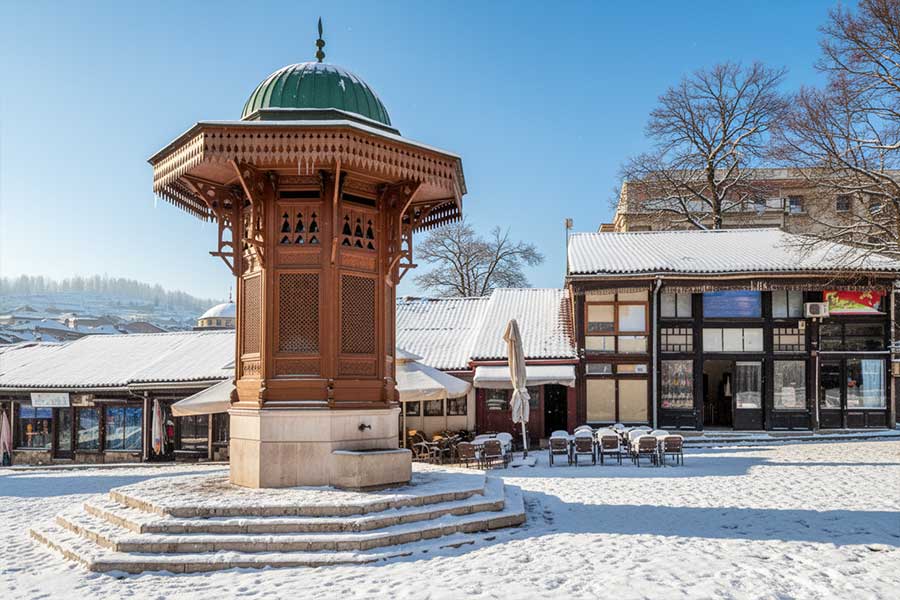
Let’s be real – no photo of Sarajevo is complete without Sebilj. But did you know that this wooden hexagon is actually a replica from 1891? The original burned down – a tragedy back then equal to the internet is down today.
Legend says: whoever drinks from Sebiljs fountain will return to Sarajevo. Marketing, Ottoman style!
Gazi Husrev-Beg Mosque – Where Time Stands Still (But WiFi Works)
Built by Mimar Sinan – the same genius who designed the Süleymaniye Mosque in Istanbul. Back in 1531, this was like having Zaha Hadid design your neighborhood mosque.
Detail that changes everything: its clock shows lunar time. When it strikes 12:00 – that means sunset. Mind = blown.
Crafts: Where Hands Still Outshine Machines
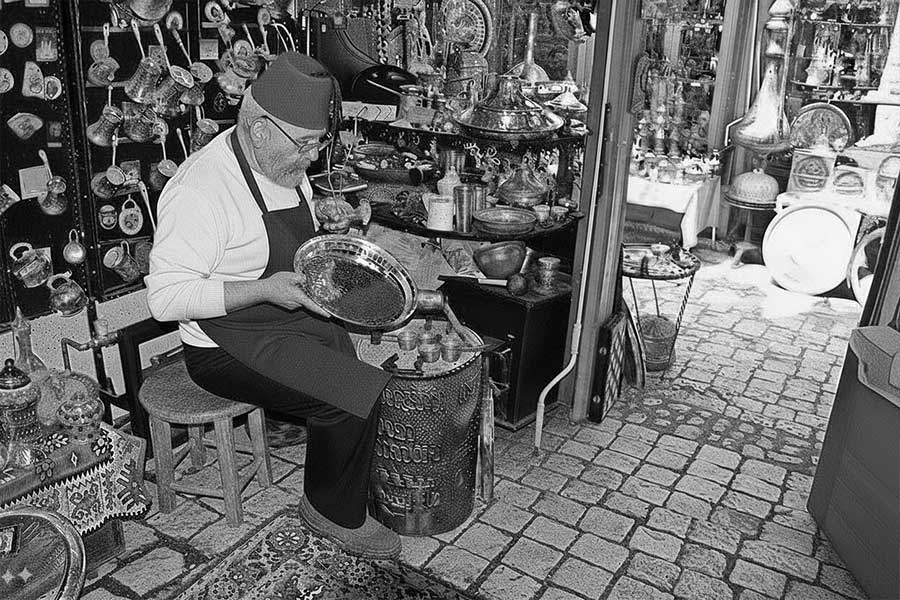
Kazandžiluk – The Street That Sounds Like an Orchestra
Close your eyes. Hear that? Tink-tink-tink. Thats not a Spotify playlist – its coppersmiths turning metal into art. The same sound for 500 years.
Pro tip: buy a džezva here. Not the Made in China souvenir shop kind. A real, heavy one. It’ll last longer than your marriage (no offense).
Zlatarska Čaršija – Where the Shine Never Fades Here, jewelers still handcraft pieces inspired by Ottoman originals. Filigree technique – so delicate that masters literally hold their breath while working
Food: Why Diets Don’t Work in Baščaršija
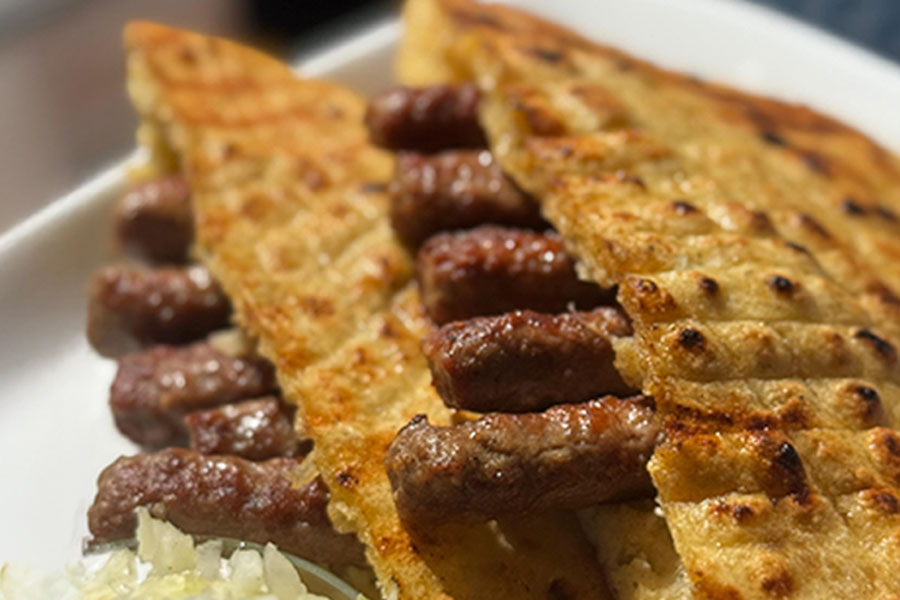
Ćevabdinice – Meat as a Religion
Željo vs. Petica Ferhatović – think Beatles vs. Rolling Stones, only with more onions.
- Ćevabdinica Željo (Kundurdžiluk 19): locals favourite. A line outside = a good sign. 10 ćevapi with kaymak and onion for 14 KM. Vegetarian option: doesn’t exist. Deal with it.
- Petica Ferhatović (Bravadžiluk 17): a bit hidden but worth it. Their bread is softer than a Hilton pillow.
- Hidden local gem – Ćevabdinica Hodžić (Bravadžiluk 34): smaller, cozier, ćevapi are chunkier. Price: your soul + 10 KM.
Aščinica ASDŽ – Grandma Cooking for 200 Grandkids a Day
Bosnian pot, dumplings, pies of every kind. No frills, just comfort. Feels like eating at someones grandmas. 815 KM per dish. Priceless.
Buregdžinica Sač (Bravadiluk 9)
Cheese burek at 7 a.m. + yogurt = better than meditation. 3 KM per piece. Calories: don’t ask.
________________________________________
Coffee Culture: Where Time Stops (And Thats Fine)
Čajdinica Dirlo (Velika Avlija): 50+ teas, rooftop shisha, hipster paradise before hipsters even existed.
Kafana Đulhan (Dženetica Čikma): interior stuck in 1953, perfect Turkish coffee, zero WiFi. Come here to escape WiFi.
Where to Sleep in Baščaršija: Dreaming Ottoman Dreams
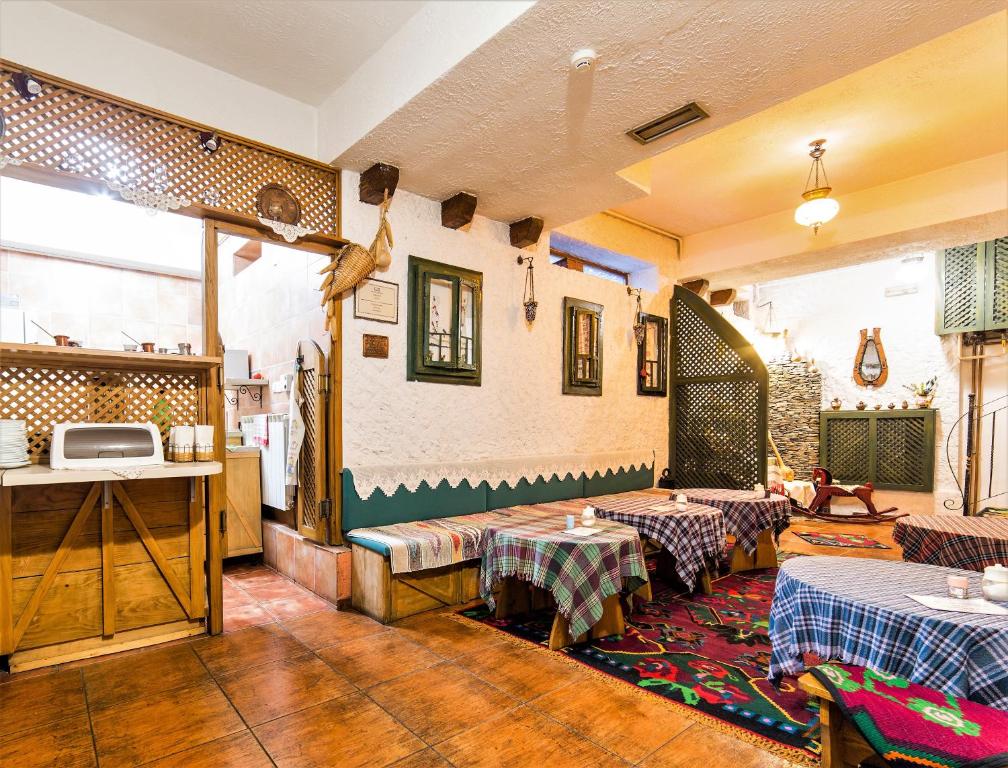
Luxury with a Story – Hotel Svrzo House: authentic 18th-century Ottoman home. 150-200 KM/night. You’re basically sleeping in a museum (with WiFi).
Mid-range with Style – Hotel Kandilj: modern twist on tradition. 80-120 KM/night. Breakfast included (and its amazing).
Budget but not cheap – Hostel Franz Ferdinand: yes, that Franz Ferdinand. 25-40 KM/bed. Location irony: free of charge.
Hidden Gems in Baščaršija: What 90% of Tourists Miss
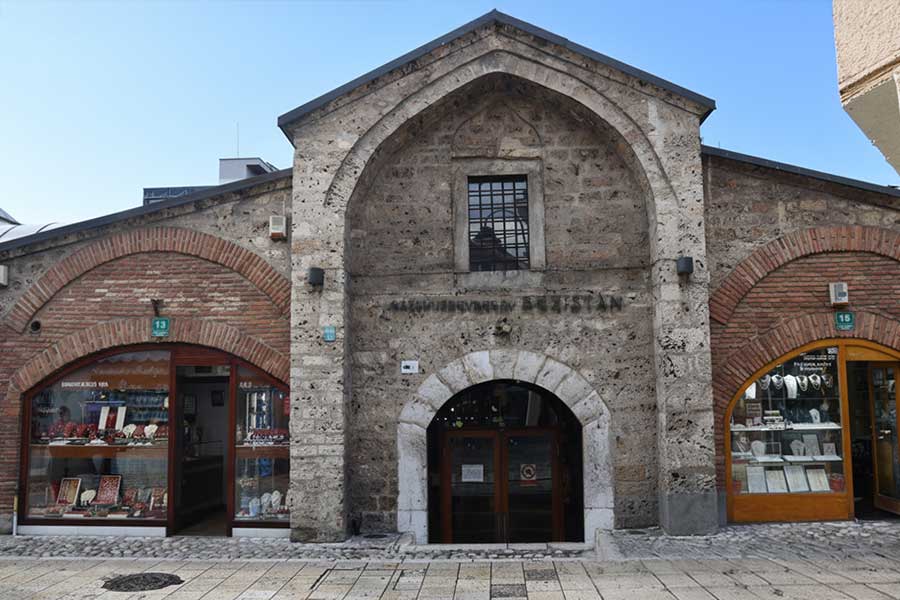
- Sarajevo Brewery Museum (Franjevačka 15): founded 1864. Entrance 4 KM. Beer tasting: 5 KM. Best money you’ll ever spend.
- Bezistan: once a silk market, now a museum. Entrance 3 KM. The spirit of old trade: free.
- City Halls Basement: ask the guard nicely – sometimes they open the secret basement showing Austro-Hungarian foundations.
Practical Tips Nobody Tells You
Cash is king
Cards work in larger restaurants and nicer souvenir shops, but small stalls, bakeries, and kiosks are often cash-only (BAM/“marks”). Keep small bills (0.50–5 KM) for quick buys and tips. ATMs are around Sebilj Square and Ferhadija.
Sticker price ≠ real price: haggling is normal
Souvenirs often start at about double. Smile + patience = best tactic. Open at ~50–60% of the asking price and meet in the middle. No haggling for food or drinks.
Shoes > fashion
Cobblestones + slopes = pain for high heels. Sneakers are ideal. In winter and spring watch for ice/rain (slippery!).
Sebilj: water is free, giving is appreciated
You can drink from the Sebilj fountain; leave a symbolic tip in the nearby box — a nice gesture to the local community.
Best photos: 06:00–07:00
Streets are empty, light is golden, and mist can hang over the Miljacka. Bonus: sunrise with Trebević in frame.
Coffee, Bosnian style
Order “Bosnian coffee.” You’ll get a džezva (pot), fildžan (cup), and a piece of lokum. Pour a little coffee into the cup, sweeten if you like, then sip slowly. Don’t pour water into the džezva.
Ćevapi & pie etiquette
Ćevapi are ordered by piece (5, 7, 10…). Ask for onions on the side if you don’t want them. “Burek” means meat; cheese/spinach are “sirnica”/“zeljanica.” When it’s busy, free up your table once you’re done.
Mosques & respect
Entry is usually fine outside prayer times; cover shoulders/knees and remove shoes. Photos are ok without flash, but ask if people are praying. Fridays around noon are crowded.
Ramadan & opening hours
During Ramadan some shops close earlier or pause around iftar. After iftar Baščaršija comes alive — great vibe, but expect crowds.
Cats & pigeons are locals
They’re friendly, but don’t feed the pigeons at Sebilj — flocks gather fast and bother others.
Small customs & etiquette
- Greet with “Dobar dan”/“Zdravo” — works everywhere.
- Tip 5–10% in cafés (or round up).
- Some cafés allow smoking — ask for non-smoking if needed.
Safety & little scams
Generally safe. Watch for pickpockets at peak times and for “too helpful” offers for overpriced tours. Use official taxis (meter on).
Exchanges & prices
Exchange offices are fair but take a small fee. Some merchants give better prices for cash. If there’s no price tag, it’s likely negotiable.
Souvenirs: copper, wood, carpets
Hand-hammered copper (džezvas, trays), woodcarving, and trays are local musts. Ask about the motifs — artisans love to share. Check weight and workmanship (real copper is heavy).
Internet & eSIM
Café Wi-Fi is decent, but for reliable data get a local prepaid/eSIM — cheap and easy.
Toilets & breaks
Public toilets near Sebilj and in larger passages (keep coins handy). For shade and a sit-down, pop into the Veliki/Bezistan arcades.
Weather & seasons
Summer: hot at midday — stroll mornings/evenings. Autumn/spring: sudden showers — pack a light rain jacket. Winter: cold and slick — warm socks and grippy soles.
Photographing people
Street artisans and shopkeepers are usually fine with photos, but ask with a smile — it often earns you a better shot.
Quick phrasebook
“Gdje je Sebilj/Ferhadija?” — “Where is Sebilj/Ferhadija?”
“Koliko košta?” — “How much is it?”
“Može li jeftinije?” — “Can it be cheaper?”
“Hvala, prijatno!” — “Thanks, have a nice day!”
Epilogue: Why We Keep Coming Back
Source: dron.ba
Baščaršija isn’t a museum. It’s not a theme park. It’s a living organism with its own heartbeat. Sometimes it’ll disappoint you – you’ll see trash, smell sewage, deal with pushy sellers.
But then…
You’ll hear the muezzin calling to prayer as church bells ring. You’ll see an old woman feeding pigeons with the same motions for 40 years. You’ll smell fresh burek at 6 a.m. You’ll hear a craftsman hammering copper while softly singing sevdalinka.
And you’ll realize – Baščaršija isn’t a destination. Its an experience. A feeling. Sarajevo in its rawest, most authentic, most beautiful form.
The water at Sebilj is waiting. And yes, you’ll be back. Everyone comes back.
Useful Info
- Best time to visit: April-June, September-October
- How long to stay: Minimum 1 day, ideally 2-3
- Budget: 50-100 KM per person/day (food + souvenirs)
- Language: Bosnian, but English works everywhere
- Final Pro Tip: Download Google Maps. Then get lost. The best things in Baščaršija aren’t on the map.
It’s spelled Baščaršija, but it reads as love at first sight.
Our Most Popular Tours To Sarajevo
We offer many tours that include a visit to Sarajevo and its most popular locations:
- Sarajevo Siege Tour & War Tunnel 1992 / 1996 (Most Popular)
- Full Day tour from Sarajevo to Međugorije & Mostar
- Full Day Tour from Sarajevo to Travnik and Jajce
- Full-Day 5 Cities Tour from Sarajevo to Herzegovina (Mostar)
- Full day Tour from Sarajevo to Dubrovnik (Kotor or Split)
- Full Day tour from Sarajevo to Belgrade
Don’t Hesitate To Say Hi!
Got any questions about our tours or the city? Don’t hesitate to contact us anytime for more info and booking.
Use the following phone number and email:

